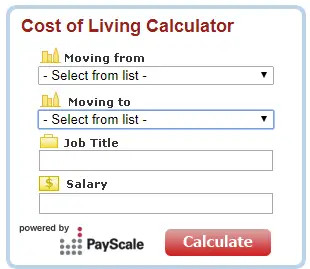"The cost of living is the cost of maintaining a certain lifestyle'" it varies from city to city and place to place and even from person to person.
The best any calculator can do is to compare averages for a variety of items including food, housing, gas, healthcare, etc. and see how the cost in one city compares to purchasing those same items in another city.
Compare Two Cities Cost of Living
To find the difference in the cost of living from where you are living now to where you are moving to, select the city you are moving from and the city you are moving to and then click Calculate.
If you enter both a job title and salary you will be presented with salary comparisons between locations. If you only enter cities the Cost of Living Calculator will generate a chart comparing the overall cost of living differences between the two cities as well as the difference in groceries, housing, utilities, transportation and health care. You will also be presented a chart comparing your new city with other major cities such as Miami, Anchorage, Dallas, New York and Knoxville.

In a few simple steps, our cost of living calculator will provide a cost of living comparison. Just tell us your current city and the city you'd like to compare it to and the calculator will show a side by side comparison. Thus it is easy to see if you could maintain your current standard of living if you accept a job in a new city. For instance if you want to compare the cost of living in Chicago with the cost of living in Richmond VA or Miami or Anchorage simply use the Cost of Living Calculator below.
Clicking Calculator Image Below will open a new window with calcuator in it
All cost of living calculators including the one above are based on a "cost of living index" where the average city is equal to 100. The cost of living in high cost cities like New York or Los Angeles will be well above 100 and the cost of living in low cost cities will be below 100. The various components of the index are given different weights depending on estimates of what percentage of thier income an average family will spend on the various components.
In the data collected in the 2010 census Akron, Ohio was very near "average" at 100.2. In the BLS index groceries count for 13% of the total and were above average cost at an idex value of 105.1, Utilities (10% of total) were 107.9, Transportation (12%) were 107.1 but living costs were mitigated by Housing (29% at 99.7, Health Care (4%) at 86.8 and Misc. goods and services (32%) at 96.0. When all of the factors are combined the cost of living in Akron is very near the average for all cities in the U.S.
The index does not measure inflation, but does compare prices at a single point in time.
Some high cost of living cities include Anchorage,Alaska at 128.4, Baltimore Maryland at 119.4, Boston, Massachusetts at 132.5, Honolulu, Hawaii at 165.7, Los Angeles, California at 136.4, Philadelphia, Pennsylvania at 126.5, Washington, D.C. at 140.1 and Manhattan, New York at a whopping 216.7.
Low cost of living cities include Amarillo, Texas at 89.5, Conway, Arkansas at 86.6, Dodge City, Kansas at 89.3, Douglas, Georgia at 88.6, Greenville, South Carolina at 90.3, Indianapolis, Indiana at 87.2, Johnson City, Tennessee at 86.7, Louisville, Kentucky at 87.7, Pueblo, Colorado at 85.6 and Springfield, Illinois at 85.8.
It is interesting to note that even within the same state there may be both high and lost cost places to live. For instance, the cost of living in Rochester, N.Y. at 100.0 is exactly average but New York City costs more than twice as much.
If you are interested in the "COLA" Cost of living adjustment check out that article. Also:
- How to calculate mpg (Miles per Gallon)
- What is the current CPI (Consumer Price Index)
- What is the current inflation rate?
- How much are you spending on gas?
- Consumer Price Index calculator
 Connect
with Tim on
Connect
with Tim on
Use our custom search to find more articles like this


Share Your Thoughts